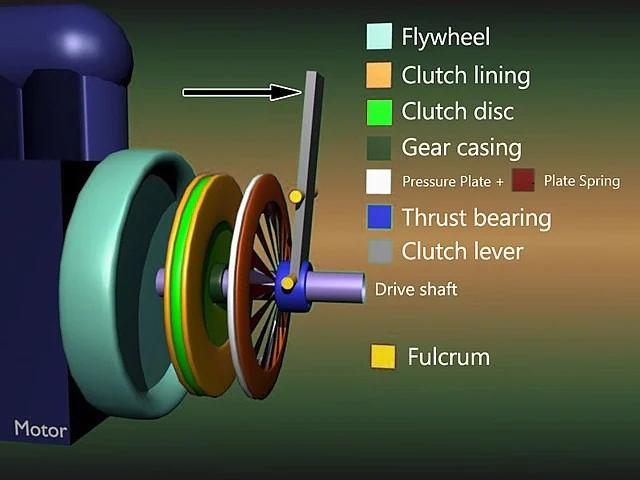The 5 Types of Clutches and How They Function

- F1 cars use multiplate clutches
- Dual Clutch transmissions run two clutches at once
- Paddle shifting cars use electromagnetic clutches
The internal combustion engine does indeed generate all that power, but without a clutch, there'd be no means for it to be converted into mechanical energy in order to propel the car forward. Keeping in mind that there is a wide range of engines and transmissions, it was essential for automakers to produce different types of clutches for various types of cars.

Friction Clutch

This is the most basic type of clutch and is also the most commonly used. The clutch is comprised of a release bearing, a pressure plate and a clutch plate and tends to be operated by a cable or by using hydraulics. The bearing is used to engage or disengage the flywheel and the transmission. Most cars tend to use a single plate clutch, however cars with powerful engines tend to use multiplate clutches in order to engage the transmission. Pressing the clutch pedal will disengage the transmission from the flywheel as doing so makes the bearings apply pressure to the springs on the pressure plate, in turn releasing the clutch plate.
Dry and wet clutches

Wet clutches tend to be a little more complexed. They are supplied with oil in order to keep them cool and lubricate the internals. These clutches are mostly used in machines that are high in torque figures. The heat generated from these powerful machines is what makes the oils necessary. Dry clutches however do not need any supply of lubricants or oils. Dry clutches usually tend to be single plated clutches. This in turn means that any lubrication could in fact slip the clutch due to lack of friction. Slipping in the clutch can drastically lose engine performance. This is the reason that wet clutches on the other hand tend to be multiplate clutches.
Multiplate Clutch
When a clutch has multiple plates of friction stacked one upon the other, the friction that is generated is on a much greater scale. This in turn allows it to handle a much larger torque output without sustaining any damage. The stacking of these plates enables them to fit into the same size fitment as a regular friction clutch. These clutches are mainly used for extreme high-performance motorsports such as the Formula series and the WRC respectively.
Dual Clutch mechanisms
In the premium car market segment, most cars are equipped with a dual-clutch transmission. The mechanisms comprise of using a small clutch for even gears and one large clutch for the odd ones. Due to the fast changes in gears using a DCT, they are now widely used in various types of cars such as supercars, sports cars, and even hot hatches. The fact that one clutch is engaged at all times while the other wait for input allows seamless quick shifts.
Electromagnetic and Electrohydraulic clutches
Electromagnetic clutches are usually used when there is a certain disregard for the health and life of the mechanical components that comprise the concept of shifting. This clutch setup revolves around the process of the clutch being engaged simply by proximity sensors on the shifter or the push of a button. This remote activation of the clutch comes into play through a DC current that passes through an electromagnet that in turn creates a magnetic field. These clutch systems are most common in automotive with paddle shifter systems. Pulling on any of the paddles sends an electrical signal to the clutch to disengage and engage hydraulically once shifted into the right gear. An electromagnetic clutch creates an environment where a clutch paddle is not needed at all.
Trending News
 1 min readYamaha YZF-R2 Name Trademarked In India
1 min readYamaha YZF-R2 Name Trademarked In India
Latest News
 car&bike Team | Dec 21, 2025KTM To Host First Adventure Rally In India In Feb 2026KTM also announced a third season of its KTM Cup for India, which commences in January 2026.1 min read
car&bike Team | Dec 21, 2025KTM To Host First Adventure Rally In India In Feb 2026KTM also announced a third season of its KTM Cup for India, which commences in January 2026.1 min read car&bike Team | Dec 20, 2025KTM 390 Adventure R To Be Launched In January 2026Bookings for the KTM 390 Adventure R are expected to open very soon, wit deliveries beginning in January 2026.2 mins read
car&bike Team | Dec 20, 2025KTM 390 Adventure R To Be Launched In January 2026Bookings for the KTM 390 Adventure R are expected to open very soon, wit deliveries beginning in January 2026.2 mins read car&bike Team | Dec 20, 2025BMW Motorrad India To Hike Prices By Up To 6 Per Cent From 2026The price hike will come into effect from January 1, 2026, and will be across the range of BMW two-wheelers and is due to the rupee’s sharp depreciation.1 min read
car&bike Team | Dec 20, 2025BMW Motorrad India To Hike Prices By Up To 6 Per Cent From 2026The price hike will come into effect from January 1, 2026, and will be across the range of BMW two-wheelers and is due to the rupee’s sharp depreciation.1 min read car&bike Team | Dec 19, 2025Next-gen Audi Q3 Spied In India Ahead Of Launch In 2026Third-gen Q3 made its global debut in mid-2025, getting notable tech upgrades and electrified powertrain options.2 mins read
car&bike Team | Dec 19, 2025Next-gen Audi Q3 Spied In India Ahead Of Launch In 2026Third-gen Q3 made its global debut in mid-2025, getting notable tech upgrades and electrified powertrain options.2 mins read car&bike Team | Dec 19, 2025Yamaha YZF-R2 Name Trademarked In IndiaThe Yamaha R15, one of Yamaha India’s most popular motorcycle models, is likely to continue, even when the R2 finally makes it debut.1 min read
car&bike Team | Dec 19, 2025Yamaha YZF-R2 Name Trademarked In IndiaThe Yamaha R15, one of Yamaha India’s most popular motorcycle models, is likely to continue, even when the R2 finally makes it debut.1 min read car&bike Team | Dec 18, 2025KTM 160 Duke With TFT Dash launched At Rs 1.79 LakhThe 5-inch colour TFT dash is borrowed from the 390 Duke and is shared across the brand’s sub-400cc lineup.2 mins read
car&bike Team | Dec 18, 2025KTM 160 Duke With TFT Dash launched At Rs 1.79 LakhThe 5-inch colour TFT dash is borrowed from the 390 Duke and is shared across the brand’s sub-400cc lineup.2 mins read
 Bilal Firfiray | Dec 19, 2025Maruti Suzuki e-Vitara Review: Worth The Wait?After a long wait, the first-ever electric Maruti Suzuki is here. It’s the e-Vitara, and it comes with a few promises. But arriving this late, is it worth the wait? Or is it a case of too little, too late?9 mins read
Bilal Firfiray | Dec 19, 2025Maruti Suzuki e-Vitara Review: Worth The Wait?After a long wait, the first-ever electric Maruti Suzuki is here. It’s the e-Vitara, and it comes with a few promises. But arriving this late, is it worth the wait? Or is it a case of too little, too late?9 mins read Bilal Firfiray | Dec 18, 2025Mercedes-Benz G450d: The Subtle Power of EvolutionThe Mercedes-Benz G 450d evolves subtly with more power, improved efficiency, and modern tech, while staying true to the timeless G-Class design. And character.4 mins read
Bilal Firfiray | Dec 18, 2025Mercedes-Benz G450d: The Subtle Power of EvolutionThe Mercedes-Benz G 450d evolves subtly with more power, improved efficiency, and modern tech, while staying true to the timeless G-Class design. And character.4 mins read Janak Sorap | Dec 11, 2025Harley-Davidson X440 T First Ride Review: Smarter and SharperHarley-Davidson has taken the X440 and given it a more focused and engaging twist. The result is the X440 T—essentially the same platform but updated in areas that give the motorcycle more appeal and riders more thrill.5 mins read
Janak Sorap | Dec 11, 2025Harley-Davidson X440 T First Ride Review: Smarter and SharperHarley-Davidson has taken the X440 and given it a more focused and engaging twist. The result is the X440 T—essentially the same platform but updated in areas that give the motorcycle more appeal and riders more thrill.5 mins read Shams Raza Naqvi | Dec 10, 20252025 Mini Cooper Convertible Review: More Colour On Indian RoadsThe updated Mini Cooper Convertible is set to be launched in the Indian market in the next few days. We drive it around Jaisalmer for a quick review.5 mins read
Shams Raza Naqvi | Dec 10, 20252025 Mini Cooper Convertible Review: More Colour On Indian RoadsThe updated Mini Cooper Convertible is set to be launched in the Indian market in the next few days. We drive it around Jaisalmer for a quick review.5 mins read Preetam Bora | Dec 21, 20252025 Ducati Multistrada V4 S Review: Seriously Addictive!For 2025, the Ducati Multistrada V4 gets sharper, smarter and more sophisticated. We spent several days with the updated Multistrada V4 S to answer the big question – with a price tag north of Rs. 30 lakh, is it worth splurging?8 mins read
Preetam Bora | Dec 21, 20252025 Ducati Multistrada V4 S Review: Seriously Addictive!For 2025, the Ducati Multistrada V4 gets sharper, smarter and more sophisticated. We spent several days with the updated Multistrada V4 S to answer the big question – with a price tag north of Rs. 30 lakh, is it worth splurging?8 mins read































































































































